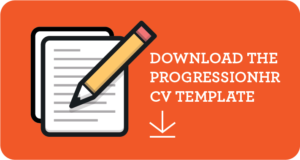We get asked for CV templates and tips all the time. We appreciate how much harder it is to put together your own CV rather than helping a friend with theirs. So, here are 12 simple but effective tips to help your CV hit the mark. These are not hard and fast rules, as every job application is different.
Use reverse chronological order
Start with your most recent job first and work backwards. This allows people to see what you’ve been doing in the most recent years. Each job history should include employer’s name, employment dates, job titles, job description, accomplishments.
Keep it to 3-4 pages
We believe three to four pages is about right for experienced professionals. If you’re earlier in your career, two pages will be enough. Your CV is better to be succinct and clear rather than padded out.
Highlight key achievements
While your regular duties are important, what matters more are your most impressive accomplishments. Make sure these are compelling. Use key achievements to outline the depth of your capabilities. Be specific – use numbers to represent your success if you can. For example, reduced employee turnover by 15% and increased retention from 10% to 85%.
You might also find our previous article about “Putting your commercial foot forward” if you wish to read up more on this.
Your CV is a sales document
It’s not a list of everything you’ve done in your career. Avoid including school grades and full lists of every course you’ve attended. When applying for a role, think about the key skills and experience you can bring and rearrange your key achievements to highlight the most relevant areas.
Don’t include a photo of yourself
Unless you’re a professional where your appearance affects the work you get (model or actor) you shouldn’t include a photo of yourself. Your appearance has nothing to do with your ability to do a job, and you unwittingly increase the risk you could be discriminated against. It’s relatively easy for a hiring manager to find out what you look like through social media if they want to.
Include an executive summary at the top of your CV
Studies show recruiters spend on average just six seconds looking at a CV. A good summary makes a recruiter pause and draws them in to read more. Highlight your most valuable skills and achievements. No summary is better than a poor one, so if you’re going to include one spend some time getting it right.
Include your LinkedIn or website links
According to recent statistics, 89% of recruiters have used LinkedIn to fill a position at some point. And 97% of all HR and staffing professionals use LinkedIn in their recruiting efforts. Make sure your LinkedIn profile is comprehensive, up-to-date and that it matches the information on your CV. If you have a personal website, include a link to that – but only if it is well-written with a professional look and feel.
Have a professional email address
Use a private email address, not your address at your current employer. Make sure it looks professional and doesn’t hint at your age. For example, ‘partyguy84@gmail.com’ won’t inspire confidence. And don’t use an email beyond a standard deviation of your name, such as ‘dancediva@’. If you have to, create a new Gmail account and forward that email to your existing one.
Don’t write in the third person
The third person point-of-view belongs to the person being talked about (he, she, herself, etc). Never use the third person or write your CV like a story – we know you’re the one who has written the CV (and it sounds odd). Instead, write in the first person, but don’t use pronouns (I, we).
Group contracts together
If you have a period of contracting, lump that experience together, rather than writing about each individual contract.
Overseas candidate
If you’re an overseas candidate, state your visa status clearly at the top of your CV. The recruiter wants to know you have the right to work here before they go any further.
CV Templates make the difference!
Remember, you never get a second chance to make a first impression. Choose a great CV template and you’re off to a winning start!
A CV template can give you a valuable head start in your job search. Besides you, your CV is your most important tool in your hunt for a job. A CV template that is well-designed and a CV that is well-written is often the difference between getting an interview and ending up in the recycling bin.
Remember you’ve got six seconds, so it pays to make your CV the best it possibly can be. The good news is, there are plenty of CV tools on the internet that are either free or available at minimal cost. Use them to put your best foot forward.
We have created a CV template that is free for you to use, and you can download this in the below link.
A CV template site we like is www.visualcv.com. It has lots of excellent CV template examples. One of our favourites is the free CV template, MONTE.
Another site is uptowork.com. This is a paid CV builder, with many CV templates and CV writing tips. They even have a tracking tool that lets you see when your CV has been opened.
And a few final things to remember: check for typos and spelling errors, and avoid including negative information.


